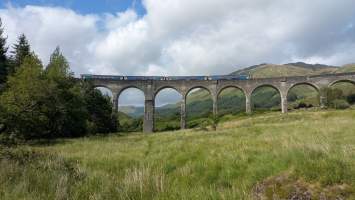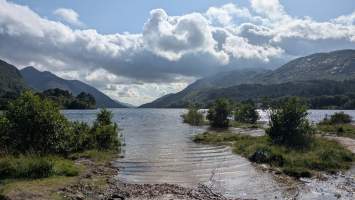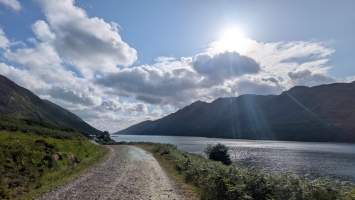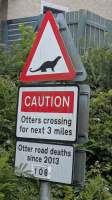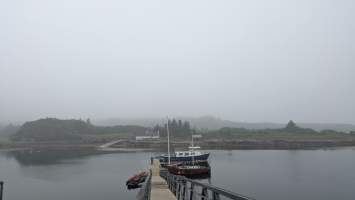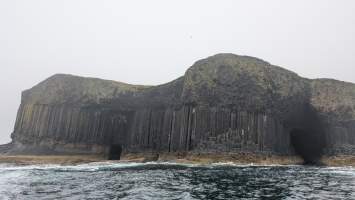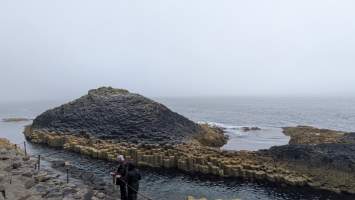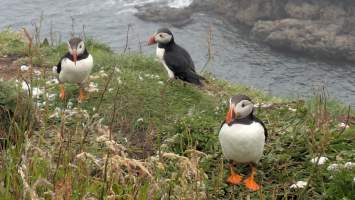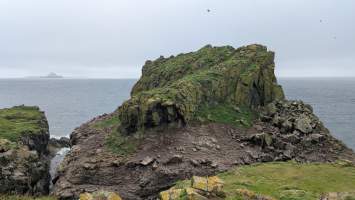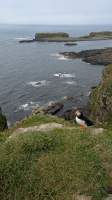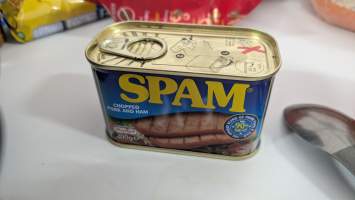Glenfinnan
At Fort William we got off the train and embarked on the second part of our Scottish voyage. We dipped into Glen Nevis for a bit before turning west on the coastal road to Glenfinnan. Originally the plan was to take the ferry over Loch Linnhe and then use the quiet road on the south shore of Loch Eil, however the ferry operators insist on a siesta in the afternoon and we'd have lost a few hours waiting for the next sailing.
We reached the Glenfinnan viaduct just minutes too late to pick up our free hot beverage which we were entitled to as cyclists at the visitor center. Tough luck. The view of the structure is breathtaking nevertheless! We were lucky again to see a train pass over the viaduct from below, a spectacularsight.
Loch Shiel
At the Glenfinnan Monument we had a snack break under the camera eyes of dozens of Asian tourists but we enjoyed the panorama of Loch Shiel regardless. The loch, despite its fjordesque appearance, is actually a freshwater lake, the fourth longest in Scotland. The footpath to the road along its south shore was gone -- literally, some segments were missing from an elevated section that was built over some rocks at the shore. Thus we backtracked to the main access road and one climb later we were back on track.
Fjord-like though it was, this clearly wasn't Norway; the dismal state of the road gave it away. The shoddy gravel surface brought the 40 mm Marathon tires on my bike to their limits. Halfway into the loch it improved a bit, but not much as the road was now covered in a thin layer of mud.
The scenery however was worth the struggle a thousand times! And it was quiet. So much that we didn't encounter any cars, humans, even wildlife except for the odd bird for hours. Loch Shiel thus earned itself an instant favorite spot in our itinerary.
Keeping in line with the rugged flair of this part of the world, the climb out of the Shiel valley proved a challenge with its slopes that reached gradients of 17 %. For us that meant pushing the bikes for about a kilometer before we reached the pass that took us to Strontian. There we stayed for the night at the midge infested but tranquil campsite.
Isle of Mull
The next morning -- it was day four since our Grand Depart in Aberdour -- we raced to catch the ferry to Fishnish on the misty Isle of Mull. Until that point the weather had been holding up with only sporadic bouts of rain. Mere minutes though after we landed on Mull a wall of fog and rain was building up ahead of us. We consulted the Met Office forecast, it looked grim: continuous rain awaited us for almost the next 24 hours. After some wrestling with our plans for the day we decided to pass on Tobermory and head directly to the campsite on Loch na Keal. There we spent the afternoon and the night holed up in our tent, resting ahead of the big day.
Staffa and Lunga
After we missed out on the puffin safari the year before we gave the matter a bit more forethought this year. Staffa and Lunga had been my first choice for a birdwatching excursion but I had scouted multiple fallbacks along our route in case it didn't work out. Thankfully it did work out and together with about fourty bird enthusiasts we boarded the boat to the islands on the Ulva ferry pier.
The first stop was Staffa, famous for its basalt rock formations. The docking process was already adventurous with the boat rocking back and forth on the unruly waters. After a walk on a kind of via ferrata to Fingal's cave, largest of a number of basalt caves, we hiked to the other end of the island where a few puffins breed. The birds are more reserved here and it takes some patience to spot them. Geology clearly beats biology on this island as the panoramas of bizarre rock formations are stunning to behold! An hour later we were back in the boat en route for the main attraction of the day: Lunga.
Largest island of the Treshnish Islands archipelago, Lunga serves as the breeding ground for thousands of birds, mainly puffins but also many more species such as guillemots, seagulls, storm-petrels and razorbills. Each bird prefers a different part of the cliffs to raise their offspring on, but they often overlap. Like they do on Harp Rock, the prime piece of real estate on the island. There on the cliffs looming over the raging sea the cacophony of thousands of screaming birds fills the misty air.
Puffins, the rock stars among the seabirds of the northern hemisphere, dart out of their nests into the foam below to return minutes later with a bill stuffed with fish. It was amazing how close they would let humans approach before shying away; they appeared almost tame. As though they enjoyed posing for pictures, megabytes of which were about to clog the Instagram feeds of our co-visitors.
Back on Mull we backtracked to Fishnish and then rode further down the coast to camp in Craignure with a superb view of the coast. Oban and the ferry to Barra were waiting.
